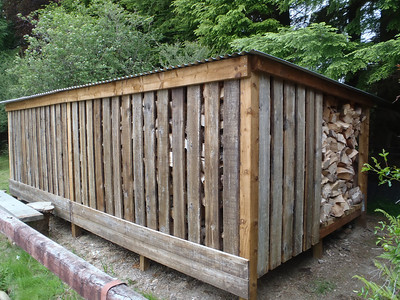Hi Folks,
Just had a great half term week including two days in the woods. Dropped 8 oaks (18 to 24 inches) and hauled 4 of them home. I split a half cords worth of rounds yesterday and the wood is damn fine. We've kept about 6 straight sections and we'll be having a go milling them later in the summer.
Anyway, we have reached the point where we need to start thinking about long term storage/seasoning. We have enough oak available to get a good few years ahead with some grunt work to get it dropped and processed. Ultimately I want to get things streamlined to minimize handling - the processing area is a bloody long way from the back door where the wood is eventually needed and even with the trailer on the mower it is time consuming getting round the property.
I was thinking of building a large covered woodshed that we can simply throw splits into. I know this isn't the fastest or best way to season but given we have the scope to season for an extra year by getting further ahead it doesn't seem so unreasonable. I thought that building a long thin shed with slatted wall for air circulation and compartments sized for around 1 year's worth of wood might do the trick. I'd locate it right beside the area where the rounds are dropped so the splits are just in tossing distance.
The image on this page is sort of what I had in mind:
http://mikeandmelssugarshack.wordpress.com/2007/03/29/wednesday-march-28-2007/wood-shed/
I'd space the slats on the walls a little wider to allow more air flow, and I'd also have internal dividing walls reaching up full height. The front section would have removable boards so the wood can be stacked higher.
I guess my real questions are:
How much slower would seasoning in a shed like this be?
Anyone use a low-handling system like this? how much time and effort do you think you save?
If you have a shed like this - what did you wish you knew before you started and what would you have built differently?
Cheers
Mike
Just had a great half term week including two days in the woods. Dropped 8 oaks (18 to 24 inches) and hauled 4 of them home. I split a half cords worth of rounds yesterday and the wood is damn fine. We've kept about 6 straight sections and we'll be having a go milling them later in the summer.
Anyway, we have reached the point where we need to start thinking about long term storage/seasoning. We have enough oak available to get a good few years ahead with some grunt work to get it dropped and processed. Ultimately I want to get things streamlined to minimize handling - the processing area is a bloody long way from the back door where the wood is eventually needed and even with the trailer on the mower it is time consuming getting round the property.
I was thinking of building a large covered woodshed that we can simply throw splits into. I know this isn't the fastest or best way to season but given we have the scope to season for an extra year by getting further ahead it doesn't seem so unreasonable. I thought that building a long thin shed with slatted wall for air circulation and compartments sized for around 1 year's worth of wood might do the trick. I'd locate it right beside the area where the rounds are dropped so the splits are just in tossing distance.
The image on this page is sort of what I had in mind:
http://mikeandmelssugarshack.wordpress.com/2007/03/29/wednesday-march-28-2007/wood-shed/
I'd space the slats on the walls a little wider to allow more air flow, and I'd also have internal dividing walls reaching up full height. The front section would have removable boards so the wood can be stacked higher.
I guess my real questions are:
How much slower would seasoning in a shed like this be?
Anyone use a low-handling system like this? how much time and effort do you think you save?
If you have a shed like this - what did you wish you knew before you started and what would you have built differently?
Cheers
Mike



